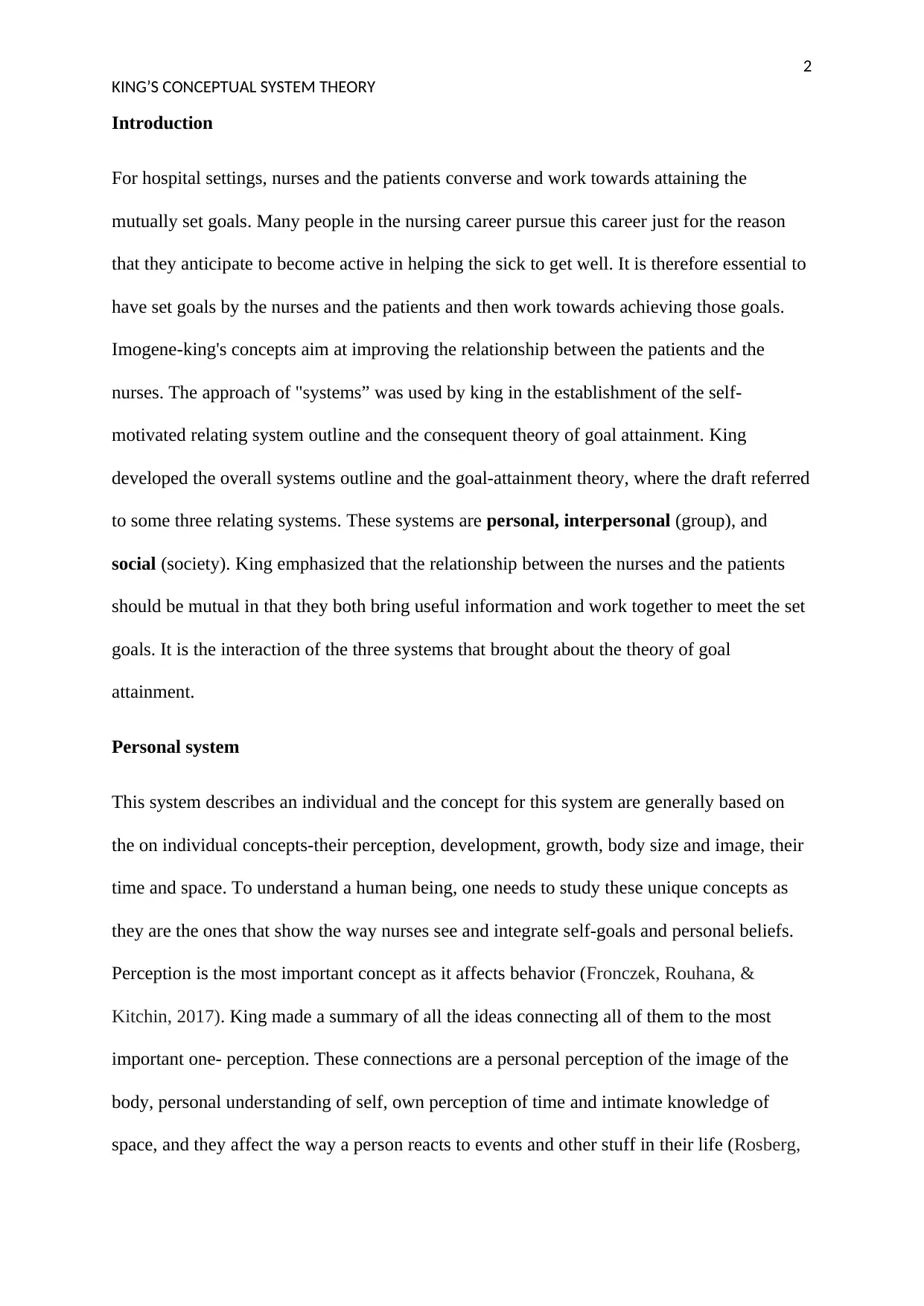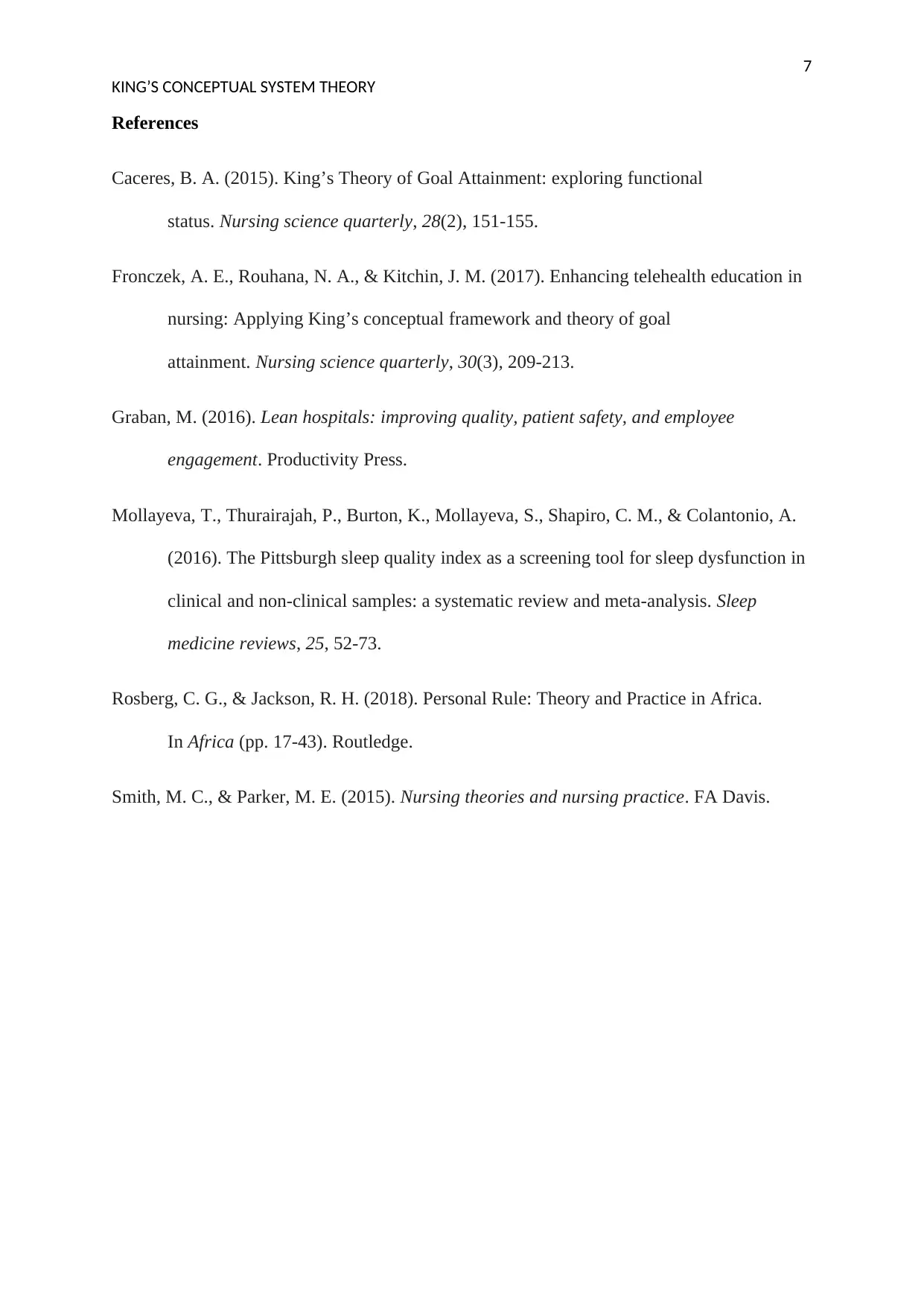Analyzing King's Conceptual System Theory for Improved Patient Care
VerifiedAdded on 2023/03/31
|7
|1413
|215
Essay
AI Summary
This essay provides an overview of Imogene King's Conceptual System Theory and its application in nursing practice. It delves into the three relating systems: personal, interpersonal, and social, highlighting their interaction in achieving goal attainment. The essay discusses the importance of communication and mutual goal setting between nurses and patients for improved healthcare outcomes. It addresses clinical quality problems and demonstrates how King's theory can be applied in various healthcare settings, such as post-cholecystectomy surgery care. The essay also touches upon the impact of technology on nursing practices and the need for nurses to adapt and take on more significant roles. Ultimately, it concludes that King's theory plays a vital role in defining nurse-patient relationships and aligning healthcare services with the goal of improved patient health.

Running head: KING’S CONCEPTUAL SYSTEM THEORY
1
TOPIC: KING’S CONCEPTUAL SYSTEM THEORY
Student’s name
Institution affiliate
Date
1
TOPIC: KING’S CONCEPTUAL SYSTEM THEORY
Student’s name
Institution affiliate
Date
Paraphrase This Document
Need a fresh take? Get an instant paraphrase of this document with our AI Paraphraser

2
KING’S CONCEPTUAL SYSTEM THEORY
Introduction
For hospital settings, nurses and the patients converse and work towards attaining the
mutually set goals. Many people in the nursing career pursue this career just for the reason
that they anticipate to become active in helping the sick to get well. It is therefore essential to
have set goals by the nurses and the patients and then work towards achieving those goals.
Imogene-king's concepts aim at improving the relationship between the patients and the
nurses. The approach of "systems” was used by king in the establishment of the self-
motivated relating system outline and the consequent theory of goal attainment. King
developed the overall systems outline and the goal-attainment theory, where the draft referred
to some three relating systems. These systems are personal, interpersonal (group), and
social (society). King emphasized that the relationship between the nurses and the patients
should be mutual in that they both bring useful information and work together to meet the set
goals. It is the interaction of the three systems that brought about the theory of goal
attainment.
Personal system
This system describes an individual and the concept for this system are generally based on
the on individual concepts-their perception, development, growth, body size and image, their
time and space. To understand a human being, one needs to study these unique concepts as
they are the ones that show the way nurses see and integrate self-goals and personal beliefs.
Perception is the most important concept as it affects behavior (Fronczek, Rouhana, &
Kitchin, 2017). King made a summary of all the ideas connecting all of them to the most
important one- perception. These connections are a personal perception of the image of the
body, personal understanding of self, own perception of time and intimate knowledge of
space, and they affect the way a person reacts to events and other stuff in their life (Rosberg,
KING’S CONCEPTUAL SYSTEM THEORY
Introduction
For hospital settings, nurses and the patients converse and work towards attaining the
mutually set goals. Many people in the nursing career pursue this career just for the reason
that they anticipate to become active in helping the sick to get well. It is therefore essential to
have set goals by the nurses and the patients and then work towards achieving those goals.
Imogene-king's concepts aim at improving the relationship between the patients and the
nurses. The approach of "systems” was used by king in the establishment of the self-
motivated relating system outline and the consequent theory of goal attainment. King
developed the overall systems outline and the goal-attainment theory, where the draft referred
to some three relating systems. These systems are personal, interpersonal (group), and
social (society). King emphasized that the relationship between the nurses and the patients
should be mutual in that they both bring useful information and work together to meet the set
goals. It is the interaction of the three systems that brought about the theory of goal
attainment.
Personal system
This system describes an individual and the concept for this system are generally based on
the on individual concepts-their perception, development, growth, body size and image, their
time and space. To understand a human being, one needs to study these unique concepts as
they are the ones that show the way nurses see and integrate self-goals and personal beliefs.
Perception is the most important concept as it affects behavior (Fronczek, Rouhana, &
Kitchin, 2017). King made a summary of all the ideas connecting all of them to the most
important one- perception. These connections are a personal perception of the image of the
body, personal understanding of self, own perception of time and intimate knowledge of
space, and they affect the way a person reacts to events and other stuff in their life (Rosberg,

3
KING’S CONCEPTUAL SYSTEM THEORY
& Jackson, 2018). Nurses have their own set goals as well as the patient’s goals and by use of
the king’s theory would challenge the nurses to become more effective and better.
Interpersonal system
This system has many concepts associated with it. They include; - the role, the transaction
stress, interaction, and communication. King used different terms to refer to the number of
individuals in this system. She referred to two as dyads to three individuals as triads and
small group for more than three individuals who can also be referred to as a large group. This
system shows the interaction between the patients and the nurse or the nurse with a co-
worker. This system puts more weight on the patient-nurse interaction. The nurse and patient
communication can be either verbal or not verbal, and the collaboration between the two is
vital for the achievement of the set goal (Caceres, 2015).
Social system
This is the final system among the three relating systems. This system shows the interaction
of nurses with patients, other hospitals, colleagues, and supervisors. The people included in
this system are people from the same society or community, and they share the same goal and
interests and embrace the same values. The system provides an outline for social contact and
associations and the rules governing their behavior. This kind of systems is planned on the
bases of ethics, and practices established to uphold the values and the different ways of
regulating these roles and practices. Examples of this system include; - family groups,
religious affiliations, gender, social class, wealth categories, etc. There is a need for the
nurses to improve in educating the patients on goal setting for their betterment and by using
the king’s theory, it would challenge them keep up the education need.
Clinical quality problem
KING’S CONCEPTUAL SYSTEM THEORY
& Jackson, 2018). Nurses have their own set goals as well as the patient’s goals and by use of
the king’s theory would challenge the nurses to become more effective and better.
Interpersonal system
This system has many concepts associated with it. They include; - the role, the transaction
stress, interaction, and communication. King used different terms to refer to the number of
individuals in this system. She referred to two as dyads to three individuals as triads and
small group for more than three individuals who can also be referred to as a large group. This
system shows the interaction between the patients and the nurse or the nurse with a co-
worker. This system puts more weight on the patient-nurse interaction. The nurse and patient
communication can be either verbal or not verbal, and the collaboration between the two is
vital for the achievement of the set goal (Caceres, 2015).
Social system
This is the final system among the three relating systems. This system shows the interaction
of nurses with patients, other hospitals, colleagues, and supervisors. The people included in
this system are people from the same society or community, and they share the same goal and
interests and embrace the same values. The system provides an outline for social contact and
associations and the rules governing their behavior. This kind of systems is planned on the
bases of ethics, and practices established to uphold the values and the different ways of
regulating these roles and practices. Examples of this system include; - family groups,
religious affiliations, gender, social class, wealth categories, etc. There is a need for the
nurses to improve in educating the patients on goal setting for their betterment and by using
the king’s theory, it would challenge them keep up the education need.
Clinical quality problem
⊘ This is a preview!⊘
Do you want full access?
Subscribe today to unlock all pages.

Trusted by 1+ million students worldwide

4
KING’S CONCEPTUAL SYSTEM THEORY
A clinical quality measure is an instrument for evaluating the observations, hospital
processes, treatment, experiences, and the results of care offered to patients. Clinical
problems are the general problems encountered in clinics that includes patient care. Clinical
quality check is vital to bring improve the services provided to patients by different health
care providers. The goal attainments theory and the connected systems can be used in
defining clinical quality issues. The nurse and the patient need to take communication to be
crucial and that the nurse-patient trust is vital (Mollayeva, Thurairajah, Burton, Mollayeva,
Shapiro, & Colantonio, 2016).
A common language for nurses worldwide would also help in uniting the nurses and thus
arises a need for advocating for that. Worldwide communication through the technical
support and the help of nursing theory, can be improved for nurses and their interdisciplinary
groups. As technology advances, there develops a need for the nurses also to be aware of the
changes to help in the modification of healthcare's future. As a result of the technology
advancement, the nurses also develops and takes charge of more significant roles such as
receiving data and information through telecommunications and reduced one-on-one
communication. Technology is, therefore, going to change nurses' practices and thus, by
king's theory, nurses are pushed to more influence over the concepts of the personal system
(Graban, 2016).
Application of king’s theory
For a patient who has gone cholecystectomy surgery, nurses need to ask themselves questions
which would eventually lead to learning whether the patients know the kind of risks that that
condition puts them in and also gain their understanding of post-operation (Smith, & Parker,
2015). Due to patients disliking ambulation after an operation, nurses need to assist the
patient to understand the risks they may be exposing themselves into by rejecting ambulation
KING’S CONCEPTUAL SYSTEM THEORY
A clinical quality measure is an instrument for evaluating the observations, hospital
processes, treatment, experiences, and the results of care offered to patients. Clinical
problems are the general problems encountered in clinics that includes patient care. Clinical
quality check is vital to bring improve the services provided to patients by different health
care providers. The goal attainments theory and the connected systems can be used in
defining clinical quality issues. The nurse and the patient need to take communication to be
crucial and that the nurse-patient trust is vital (Mollayeva, Thurairajah, Burton, Mollayeva,
Shapiro, & Colantonio, 2016).
A common language for nurses worldwide would also help in uniting the nurses and thus
arises a need for advocating for that. Worldwide communication through the technical
support and the help of nursing theory, can be improved for nurses and their interdisciplinary
groups. As technology advances, there develops a need for the nurses also to be aware of the
changes to help in the modification of healthcare's future. As a result of the technology
advancement, the nurses also develops and takes charge of more significant roles such as
receiving data and information through telecommunications and reduced one-on-one
communication. Technology is, therefore, going to change nurses' practices and thus, by
king's theory, nurses are pushed to more influence over the concepts of the personal system
(Graban, 2016).
Application of king’s theory
For a patient who has gone cholecystectomy surgery, nurses need to ask themselves questions
which would eventually lead to learning whether the patients know the kind of risks that that
condition puts them in and also gain their understanding of post-operation (Smith, & Parker,
2015). Due to patients disliking ambulation after an operation, nurses need to assist the
patient to understand the risks they may be exposing themselves into by rejecting ambulation
Paraphrase This Document
Need a fresh take? Get an instant paraphrase of this document with our AI Paraphraser

5
KING’S CONCEPTUAL SYSTEM THEORY
after a surgery and together set a goal that the patient doesn't get into the dangers brought by
post-operations ambulation and advise the patient on what to do so as to get discharged. The
nurse and the patient setting a goal together and work towards achieving it (the patient gets
discharged) is an application of the king’s theory.
Outcome alignment of a quality committee
By the use of the king’s theory in the entire research, nursing informatics were few and thus a
need arising for the project management nursing guidebooks. Giving out the guides and the
nursing informatics to clinics and other healthcare would align the institutions with improved
quality of the services offered.
Other theories that align with improved
Despite the improvements of technology, the nurses’ goal to provide the best safe
environment for the patient, remains the same. Using the interpersonal tool effectively, for
example advocacy, would bring good health care environment for the patients. Due to many
intricate health processes, intricate technologies in healthcare services, patients request and
their retort to therapeutic care, and changed organizations, this brings many chances and
challenges to improve the quality of healthcare, but many would need redesigning the entire
organization and all its services. Combining the two theories as a nurse for improving the
health needs of the patients.
Conclusion
In conclusion, the king’s conceptual system theory plays a vital role in nursing. Through the
king's theory systems, the relationship between the nurses and the patients is defined to be
mutual so that they can together set the goals they want to achieve for the betterment of the
patient's health. The theory also suggests that communication between the nurse and the
patient, nurses, and coworkers and their superiors is crucial so as attain the set goal. The
KING’S CONCEPTUAL SYSTEM THEORY
after a surgery and together set a goal that the patient doesn't get into the dangers brought by
post-operations ambulation and advise the patient on what to do so as to get discharged. The
nurse and the patient setting a goal together and work towards achieving it (the patient gets
discharged) is an application of the king’s theory.
Outcome alignment of a quality committee
By the use of the king’s theory in the entire research, nursing informatics were few and thus a
need arising for the project management nursing guidebooks. Giving out the guides and the
nursing informatics to clinics and other healthcare would align the institutions with improved
quality of the services offered.
Other theories that align with improved
Despite the improvements of technology, the nurses’ goal to provide the best safe
environment for the patient, remains the same. Using the interpersonal tool effectively, for
example advocacy, would bring good health care environment for the patients. Due to many
intricate health processes, intricate technologies in healthcare services, patients request and
their retort to therapeutic care, and changed organizations, this brings many chances and
challenges to improve the quality of healthcare, but many would need redesigning the entire
organization and all its services. Combining the two theories as a nurse for improving the
health needs of the patients.
Conclusion
In conclusion, the king’s conceptual system theory plays a vital role in nursing. Through the
king's theory systems, the relationship between the nurses and the patients is defined to be
mutual so that they can together set the goals they want to achieve for the betterment of the
patient's health. The theory also suggests that communication between the nurse and the
patient, nurses, and coworkers and their superiors is crucial so as attain the set goal. The

6
KING’S CONCEPTUAL SYSTEM THEORY
theory of goal attainment can also be used in defining clinical quality problems and aligning
healthcare services with the king’s theory.
KING’S CONCEPTUAL SYSTEM THEORY
theory of goal attainment can also be used in defining clinical quality problems and aligning
healthcare services with the king’s theory.
⊘ This is a preview!⊘
Do you want full access?
Subscribe today to unlock all pages.

Trusted by 1+ million students worldwide

7
KING’S CONCEPTUAL SYSTEM THEORY
References
Caceres, B. A. (2015). King’s Theory of Goal Attainment: exploring functional
status. Nursing science quarterly, 28(2), 151-155.
Fronczek, A. E., Rouhana, N. A., & Kitchin, J. M. (2017). Enhancing telehealth education in
nursing: Applying King’s conceptual framework and theory of goal
attainment. Nursing science quarterly, 30(3), 209-213.
Graban, M. (2016). Lean hospitals: improving quality, patient safety, and employee
engagement. Productivity Press.
Mollayeva, T., Thurairajah, P., Burton, K., Mollayeva, S., Shapiro, C. M., & Colantonio, A.
(2016). The Pittsburgh sleep quality index as a screening tool for sleep dysfunction in
clinical and non-clinical samples: a systematic review and meta-analysis. Sleep
medicine reviews, 25, 52-73.
Rosberg, C. G., & Jackson, R. H. (2018). Personal Rule: Theory and Practice in Africa.
In Africa (pp. 17-43). Routledge.
Smith, M. C., & Parker, M. E. (2015). Nursing theories and nursing practice. FA Davis.
KING’S CONCEPTUAL SYSTEM THEORY
References
Caceres, B. A. (2015). King’s Theory of Goal Attainment: exploring functional
status. Nursing science quarterly, 28(2), 151-155.
Fronczek, A. E., Rouhana, N. A., & Kitchin, J. M. (2017). Enhancing telehealth education in
nursing: Applying King’s conceptual framework and theory of goal
attainment. Nursing science quarterly, 30(3), 209-213.
Graban, M. (2016). Lean hospitals: improving quality, patient safety, and employee
engagement. Productivity Press.
Mollayeva, T., Thurairajah, P., Burton, K., Mollayeva, S., Shapiro, C. M., & Colantonio, A.
(2016). The Pittsburgh sleep quality index as a screening tool for sleep dysfunction in
clinical and non-clinical samples: a systematic review and meta-analysis. Sleep
medicine reviews, 25, 52-73.
Rosberg, C. G., & Jackson, R. H. (2018). Personal Rule: Theory and Practice in Africa.
In Africa (pp. 17-43). Routledge.
Smith, M. C., & Parker, M. E. (2015). Nursing theories and nursing practice. FA Davis.
1 out of 7
Related Documents
Your All-in-One AI-Powered Toolkit for Academic Success.
+13062052269
info@desklib.com
Available 24*7 on WhatsApp / Email
![[object Object]](/_next/static/media/star-bottom.7253800d.svg)
Unlock your academic potential
Copyright © 2020–2025 A2Z Services. All Rights Reserved. Developed and managed by ZUCOL.





